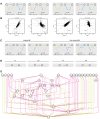Yeast glucose pathways converge on the transcriptional regulation of trehalose biosynthesis
- PMID: 22697265
- PMCID: PMC3472246
- DOI: 10.1186/1471-2164-13-239
Yeast glucose pathways converge on the transcriptional regulation of trehalose biosynthesis
Abstract
Background: Cellular glucose availability is crucial for the functioning of most biological processes. Our understanding of the glucose regulatory system has been greatly advanced by studying the model organism Saccharomyces cerevisiae, but many aspects of this system remain elusive. To understand the organisation of the glucose regulatory system, we analysed 91 deletion mutants of the different glucose signalling and metabolic pathways in Saccharomyces cerevisiae using DNA microarrays.
Results: In general, the mutations do not induce pathway-specific transcriptional responses. Instead, one main transcriptional response is discerned, which varies in direction to mimic either a high or a low glucose response. Detailed analysis uncovers established and new relationships within and between individual pathways and their members. In contrast to signalling components, metabolic components of the glucose regulatory system are transcriptionally more frequently affected. A new network approach is applied that exposes the hierarchical organisation of the glucose regulatory system.
Conclusions: The tight interconnection between the different pathways of the glucose regulatory system is reflected by the main transcriptional response observed. Tps2 and Tsl1, two enzymes involved in the biosynthesis of the storage carbohydrate trehalose, are predicted to be the most downstream transcriptional components. Epistasis analysis of tps2Δ double mutants supports this prediction. Although based on transcriptional changes only, these results suggest that all changes in perceived glucose levels ultimately lead to a shift in trehalose biosynthesis.
Figures







Similar articles
-
Characterizing phenotypic diversity of trehalose biosynthesis mutants in multiple wild strains of Saccharomyces cerevisiae.G3 (Bethesda). 2022 Nov 4;12(11):jkac196. doi: 10.1093/g3journal/jkac196. G3 (Bethesda). 2022. PMID: 35929793 Free PMC article.
-
Metabolic phenotypes of Saccharomyces cerevisiae mutants with altered trehalose 6-phosphate dynamics.Biochem J. 2013 Sep 1;454(2):227-37. doi: 10.1042/BJ20130587. Biochem J. 2013. PMID: 23763276
-
Trehalose accumulation in mutants of Saccharomyces cerevisiae deleted in the UDPG-dependent trehalose synthase-phosphatase complex.Biochim Biophys Acta. 1997 Apr 17;1335(1-2):40-50. doi: 10.1016/s0304-4165(96)00127-4. Biochim Biophys Acta. 1997. PMID: 9133641
-
Reserve carbohydrates metabolism in the yeast Saccharomyces cerevisiae.FEMS Microbiol Rev. 2001 Jan;25(1):125-45. doi: 10.1111/j.1574-6976.2001.tb00574.x. FEMS Microbiol Rev. 2001. PMID: 11152943 Review.
-
Transcriptional networks: reverse-engineering gene regulation on a global scale.Curr Opin Microbiol. 2004 Dec;7(6):638-46. doi: 10.1016/j.mib.2004.10.009. Curr Opin Microbiol. 2004. PMID: 15556037 Review.
Cited by
-
Different levels of catabolite repression optimize growth in stable and variable environments.PLoS Biol. 2014 Jan;12(1):e1001764. doi: 10.1371/journal.pbio.1001764. Epub 2014 Jan 14. PLoS Biol. 2014. PMID: 24453942 Free PMC article.
-
An Integrated Process for the Xylitol and Ethanol Production from Oil Palm Empty Fruit Bunch (OPEFB) Using Debaryomyces hansenii and Saccharomyces cerevisiae.Microorganisms. 2022 Oct 14;10(10):2036. doi: 10.3390/microorganisms10102036. Microorganisms. 2022. PMID: 36296312 Free PMC article.
-
Gene expression hallmarks of cellular ageing.Biogerontology. 2018 Dec;19(6):547-566. doi: 10.1007/s10522-018-9750-z. Epub 2018 Feb 28. Biogerontology. 2018. PMID: 29492790 Free PMC article. Review.
-
Improve carbon metabolic flux in Saccharomyces cerevisiae at high temperature by overexpressed TSL1 gene.J Ind Microbiol Biotechnol. 2013 Apr;40(3-4):345-52. doi: 10.1007/s10295-013-1233-2. Epub 2013 Feb 2. J Ind Microbiol Biotechnol. 2013. PMID: 23377879
-
Exploiting budding yeast natural variation for industrial processes.Curr Genet. 2016 Nov;62(4):745-751. doi: 10.1007/s00294-016-0602-6. Epub 2016 Apr 16. Curr Genet. 2016. PMID: 27085523 Review.
References
Publication types
MeSH terms
Substances
LinkOut - more resources
Full Text Sources
Molecular Biology Databases

